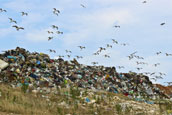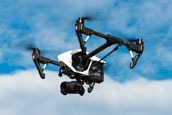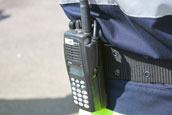Safety and territory
Airport surroundings and the protection of Aviation Safety
The area around the airport must meet specific regulatory requirements in order to ensure that aircraft engaged in landing, take-off and overfly can do so safely.
To protect the Aviation Safety the international law prescribes some rules for the territory that surrounds an airport, that which must be respected by local administrations and citizens.
Whereas section seven of the EU Regulation 139/14 sets forth:
"With regard to obstacle management in the aerodrome surroundings as well as to other activities taking place outside the aerodrome's boundary, each Member State may designate different authorities and other entities in charge of monitoring, assessment and mitigation of risks. The aim of this Regulation is not to change current allocation of tasks within the Member State. However, a seamless organisation of the competences regarding the safeguarding of aerodrome surroundings and the monitoring and mitigation of risk caused by human activities should be ensured in each Member State. It should therefore be ensured that authorities which are entrusted with responsibilities of safeguarding the surroundings of aerodromes have the adequate competencies to fulfil their obligations."
The Navigation Code - ex Article 707 - states:
[I]. In order to ensure airspace security, ENAC identifies zone to be restricted in areas adjacent to airports and establishes limits related to the obstacles to air navigation and the pertinent potential dangers, in accordance with international technical regulations. Local authorities, during planning and governing of the territory, adapt their planning tools to the ENAC requirements.
[II]. ENAC staff responsible for performing surveys and placing signals can access private property, requiring, in the case of opposition from private individuals, the assistance of the public force.
[III]. The areas referred to in the first paragraph and the related limitations are indicated by ENAC on specific maps published by filing such at the office of the municipality concerned.
[IV]. Within ten days from the date when the maps were files, notice is given in the Official Bulletin of the region concerned. The concerned commune will make this information known to individual interested parties, in the manner considered appropriate.
[V]. In the landing and take-off directions, works or activities compatible with the appropriate risk plans may be authorized by the territorial jurisdiction of the municipalities, including on the basis of any regional directives, in compliance with the ENAC Regulation on the construction and management of airports, in implementing Annex XIV ICAO.
[VI]. For military airports, the functions referred to in this article are exercised by the Ministry of Defence and governed by a decree of the Minister of Defence.
Air navigation safety









Proper conduct
Presence of areas attracting wildlife
- Regulation EC 139/14 articles 9 and 10;
- acc. to Article 707 of the Navigation Code;
- acc. to Article 711 of the Navigation Code;
- acc. to Article 714 of the Navigation Code;
- acc. to Article 715 of the Navigation Code;
Please visit the site of the National Civil Aviation Authority to review in depth the requirements set forth to avoid generating the wildlife risk around the airport (Circular ENAC APT 01B):
Presence of obstacles
To avoid generating a risk for air transport security the route required by the National Civil Aviation Authority, outlined on the website page of the ENAC must be followed closely.
Remote pilot aircraft
The use of drones is subject to binding regulatory requirements that must be observed carefully, for which please refer to the following explanatory video and related poster:
Video - Fly your drone in safety!
Poster - Fly your drone in safety!

Below is a list of national applicable regulations provided on the website of the National Civil Aviation Authority:
On the ENAC web page dedicated to remote pilot aircraft, there is a general collection of documentation in this regard:
Drones are not a toy, use them by observing all the rules prescribed by the National Authority.
Forest areas and fields
The Law regulates the foreseeability, the prevention, and active struggle against forest fires.
The Site of the State Forestry Corps - referenced - now absorbed by the Corps of Carabinieri, provides useful advice on the prevention of fires.
Chinese lanterns and other objects suspended in the atmosphere
Launching Chinese lanterns and, in general, of any object that may interfere with air traffic is governed by national regulations, through Circulars issued by the National Civil Aviation Authority (ENAC). In particular, the Circular ATM-05 regulates events and distinctive activities pertinent to air traffic.
ENAC is therefore the competent body to whom to submit the request at least 45 days before the date of the event. Further information and forms to be filled in for the authorization request are available on the ENAC website.
Airport emergency gates
It is recalled the absolute prohibition to park cars/vehicles at the airport emergency gates. Along the perimeter fence, there are gates intended for the exit/entry of rescue vehicles in the event of an aviation event. Leaving the unattended vehicle close to these gates can hinder rescue operations, with criminal consequences.
Your conduct at the airport
Conduct while boarding and disembarking the aircraft:
- Do not place devices that contain lithium batteries in your carry on luggage;
- Do not smoke;
- Do not run;
- Hold your children firmly by hand;
- Do not walk under the aircraft's wings;
- Do not litter;
- Walk slowly and carefully on the stairs while boarding and disembarking the aircraft, and make sure to use the handrails;
- Pay special attention if you carry backpacks, shoulder bags, or hand luggage, not to lose your balance while descending or ascending the boarding and disembarking the aircraft staircase; always hold the handrail.
Warning: only some of the thematic sections of the website are available in english.






